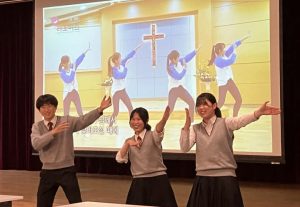Making their voices heard — 60 years after Hiroshima-Nagasaki World Peace Pilgrimage, Part 3: Peace ambassadors
Jul. 19, 2024
Spirit of “to foster peace, one friend at a time”
by Hiromi Morita, Staff Writer
“Previously, my only interests in South Korea were K-pop, dramas, and food, but through the trip, I grew interested in the relationship between Japan and South Korea. After my return to Japan, I began to explore related issues more,” said one high school student. Mentioned another, “I’m going to start studying Korean.” Last month, high school students with eyes alight described their experiences at a reporting session for the South Korea PAX (Peace Ambassador Exchange), a program sponsored by the World Friendship Center (WFC), an NPO in Hiroshima. Along with an A-bomb survivor, the students had been dispatched to South Korea through the program.
The program participants visited Seoul and other locations in South Korea from late April until early May earlier this year. While doing a homestay at the homes of people affiliated with the country’s host organization, the participants learned about the history and culture of South Korea and visited high schools and churches to communicate information about the A-bombed city of Hiroshima. They met and spoke with South Koreans about their perspectives on history and issues that preclude the attainment of peace.
PAX is one program by which exchange of delegations takes place between the WFC and peace groups in the United States and South Korea every other year. The South Korea PAX program was launched in 2003, but the exchange program with the United States has a long history. That history has continued ever since the Hiroshima-Nagasaki World Peace Pilgrimage, led by WFC founder Barbara Reynolds (who died in 1990), 60 years ago.
“With disbanding impossible, more activities are carried out based on wish for peace”
That is the headline that appeared on the society page of the Chugoku Shimbun published on December 26, 1964. It was for an article that reported on what was happening after the peace pilgrimage to its total of 40 members who had visited eight nations including nuclear powers from April through July of the same year. The article mentioned that the members had continued on with their activities despite the original plans for the pilgrimage to disband upon its return to Japan.
The group first needed to pay back money they had borrowed during the tour, but the members also apparently grew busy accommodating people they had met in various locations on the pilgrimage who were relying on help for their visits to the A-bombed Hiroshima.
Founding of WFC
That time was marked by concerns that nuclear weapons might be used in the Vietnam War. In May 1965, the pilgrimage members sent a letter of request to then U.S. President Lyndon Johnson seeking the immediate withdrawal of U.S. military forces from Vietnam. They also sent around 300 letters to U.S. organizations and individuals who they got to know during the pilgrimage, asking them to pressure the U.S. government to realize that aim.
Through the pilgrimage, Ms. Reynolds became convinced that meeting other people and fostering friendships would lead to peace. In August of that year, she and Tomin Harada, a physician and chair of the pilgrimage executive committee who died in 1999, founded the WFC in Hiroshima.
Even after Ms. Reynolds returned to the United States in 1969, the organization was supported by volunteers who had accepted and taken on her vision. In 1970, the 25th anniversary of the atomic bombings, another peace pilgrimage was arranged, following the first one in 1964. The next year, 1971, the WFC welcomed a delegation from the United States. During the period 1972–1976, that program evolved into a youth peace seminar, in which young people in Japan and the United States formed pairs to study about responsibilities with respect to peace. The exchange project has continued under the name PAX since 1991, following a teacher-exchange program.
“Get to know each other”
A-bomb survivor Masao Ito, 83, who shared his experience in the atomic bombing on the recent PAX tour, described the trip. “We are able to achieve mutual understanding not by relying on one-way communication, but by getting to know each other.” In South Korea, the opinion that the atomic bombings freed Koreans from Japan’s colonial occupation persist today. The Japanese high school students reported they sensed the differences in historical views during the program. From local high school students in South Korea, the Japanese students heard that they had come to hate Japan from their history classes. Nozomi Ishikawa, 18, a third-year student at Sotoku High School, said, “Both Japanese and South Korean students know well about the damage inflicted on our own countries but have not learned much about the damage experienced by the other country or that perpetrated by our own. I came to realize the necessity of having an objective view of history.”
Chinatsu Moriue, 17, a third-year student at Hiroshima Jogakuin High School, said, “I was worried whether the account by the A-bomb survivor of his experience in the atomic bombing would be accepted by South Koreans, but their willingness to listen to the story exceeded our expectations.” Ms. Moriue added, “Learning that people had suffered burns in the atomic bombings and that young people of the same age were caught up in the catastrophe, the South Korean high school students told us they realized it was not just someone else’s problem. The program made me aware of the importance of having dialogue as fellow human beings that transcends our own perspectives.” Most of the program participants commented that citizen-level exchange can advance relationships.
The WFC holds fast to the philosophy, “to foster peace, one friend at a time,” based on remarks made by Ms. Reynolds. In August, the WFC will welcome a delegation from the United States. The seeds sown by the pilgrimage are slowly but surely taking root in the soil.
(Originally published on July 19, 2024)








